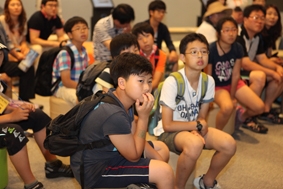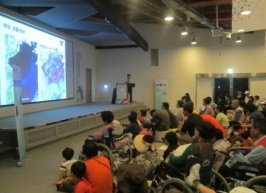After almost two years of preparations, the POGO exhibit at Expo 2012 Yeosu Korea was opened to the public on 12 May 2012, along with the many other exhibits featured in the 23 pavilions that occupy the imposing 25-hectare Expo site.
The theme of the 2012 International Expo, “the Living Ocean and Coast”, sparked POGO’s interest back in January 2010 when the Expo was first brought up by scientists of the then Korea Ocean Research and Development Institute, KORDI (now Korea Institute of Ocean Science and Technology, KIOST), during the 12th POGO Annual Meeting. A proposal was subsequently submitted and was selected by the Oceans and Coasts Best Practices Area (OCBPA) Organising Committee. POGO was allocated 150 K USD in kind to prepare its exhibit in close collaboration with the design company appointed by the OCBPA (SigongTech).
The exhibit concept that was proposed was articulated around three main themes:
- The history of ocean observations
- The institutes carrying out these observations
- Experiencing the ocean –an interactive display.
With the help of the POGO News and Information Group, who provided a lot of the material used for the exhibit, Sophie Seeyave (POGO Secretariat) worked with SigongTech to produce an exhibit that would be educational and interesting for the general public visiting the Expo. The first theme was illustrated by a time-line depicting some major events in the history of ocean observations, as well as the dates the POGO member institutions were established. Visitors could use their iPhones and the QR code system to access more detailed information about these events. The second theme consisted of a 12-minute video presenting the 37 POGO member institutions, which was created especially for the Expo (linked below). The third, and probably the most popular theme, consisted of five interactive kiosks where the visitors could experience different aspects of the ocean. They could look through a microscope at phytoplankton cells, listen to the natural and anthropogenic sounds that can be heard in the ocean, experience the pressure and light fields at different depths, and the temperature of different water masses.

microscope

temperatures of the ocean


different depths

The Theme Pavilion (that includes the OCBPA) has proved to be very popular, with long queues of people waiting to enter. Over 8 million people visited the Expo, 1 million of whom visited the OCBPA and POGO exhibit.
POGO also had the opportunity to organise a special communication event, which took place from 22 to 24 June. This consisted of a mixture of public lectures and video and film screenings.The lectures were given in Korean by Drs Seung-Hyun Son (NOAA) and Yu-Hwan Ahn (KIOST), and by Drs Yoshihisa Shirayama (JAMSTEC), Shubha Sathyendranath, Trevor Platt and Sophie Seeyave in English. The topics covered satellite oceanography and ocean colour, the Great Tohoku Earthquake of March 2011, biological oceanography and sound in the ocean. All lectures were well received by adults and children alike, and it was extremely satisfying to see the look of concentration on all the childrens’ faces, and their enthusiasm when it came to asking questions.


POGO also contributed to the preparation of the Yeosu Declaration, which was issued at the closing of the Expo. The Declaration highlights the issues of concern and priorities regarding the management of oceans and coasts and the research needed to better inform policy makers. The Declaration is linked in the sidebar.
12 May, 2012 – 12 August, 2012

EXPO 2012, Yeosu, Korea
